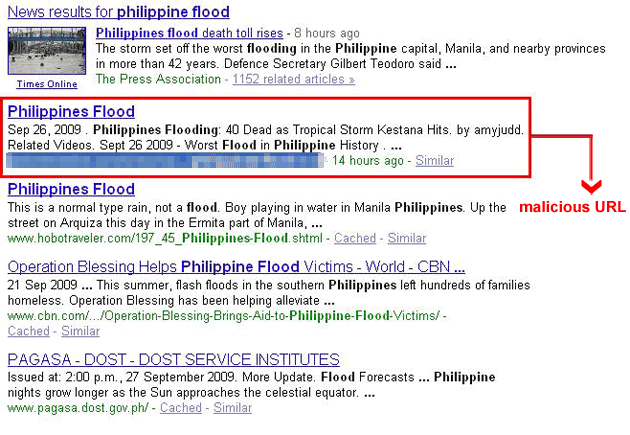Below is a consolidated report of the interactive maps, private groups and business organizations where you can find information on how to help the victims of tropical storm Ondoy, based on the sites of
INQUIRER.net columnist
Manuel Quezon III, bloggers
Frannywanny and
Jane and Google map creators Serge Gregorio and Franklin Naval.
Rescue Operations
National Disaster Coordinating Council (NDCC)
+632-9125668
+632-9111406
+632-9115061
+632-9122665
NDCC Help hotlines:
+65 734-2118
734-2120
ndcchelpdesk@gmail.com
Philippine Coast Guard
+632-5276136
Air Force
+63908-1126976
+632-8535023
Metro Manila Development Authority (136)
Marikina City Rescue (+632-6462436, +632-6462423, +632920-9072902) Pasig Rescue Emergency Number (+632-6310099)
Quezon City Rescue (161)
San Juan City Hall Command Post (+632-4681697)
Bureau of Fire Protection Region III (Central Luzon) Hotline: (+63245-9634376)
Senator Dick Gordon (+639178997898, +63938-444BOYS, +632-9342118, +632-4338528)
Senator Manny Villar (+639174226800. +639172414864, +639276751981)
Philippine National Red Cross (143, +632-5270000)
Philippine National Red Cross Rizal Chapter operations center hotline: (+632-6350922, +632-6347824)
Rubber boat and chopper requests
NCRPO (+632-8383203, +632-8383354)
Private citizens who would like to lend their motor boats for rescue please call emergency nos:
+632-9125668
+632-9111406
+632-9122665
+632-9115061
You can also text (+632917-4226800 or +632927-6751981) for rescue dump trucks.
For those who are able to lend 4×4 trucks for rescue: Please send truck to Greenhills Shopping Center Unimart Grocery to await deployment, Tel No. (+632920-9072902).
Petron & San Miguel Corporation are lending choppers for rescue operations, call/text: (+632917-8140655) ask for Lydia Ragasa
Power supply concerns
Meralco (+63917-5592824, 16211, +63920-9292824) If you want service cut off to your area to prevent fires and electrocution.
Donations of heavy duty flashlights needed for rescue operations in Cainta, Rizal area. Contact Cielo at (+632918-8824356)
E-Donations
SMS: text RED to 2899 (Globe) and 4483 (Smart)
G-Cash: text DONATEAMOUNT4-digit M-PINREDCROSS to 2882
TXTPOWER.org: Paypal, Smart Money (5577-5144-1866-7103), G-Cash (0917-9751092)
Cellphone services
For Smart, text wis to 386.
For Globe, text find to 7000.
Maps
A group composed of Serge Gregorio and Franklin Naval has put up an
interactive rescue map to locate victims in Marikina, one of the hardest hit areas by Ondoy.
Malls and commercial outlets
Aranaz Stores (Rockwell & Greenbelt) – accepting donations of any kind for Payatas communities
Coffee Bean & Tea Leaf (all branches) – canned goods, water, clothes, blankets, towels, medicine, and emergency supplies (no cash)
Luca stores (Rockwell, Shangri-la, Eastwood, or GA Towers) - Send your old clothes & donations (no cash pls)
Moonshine boutique (Rockwell) - accepting relief goods to help Ondoy victims in Marikina and Cainta.
Papemelroti stores (91 Roces Ave. / Ali Mall Cubao / SM City North EDSA / SM Fairview / SM Megamall / Glorietta 3 in Makati / SM Centerpoint / SM Southmall) – accepting relief goods (canned goods / milk / bottled water / clothes – NO CASH pls.)
Team Manila stores in Trinoma, Mall of Asia, Jupiter Bel-Air and Rockwell shall be accepting relief goods (Canned Goods, Ready-to-drink Milk, Bottled Water and Clothes) for distribution by Veritas.
Government and relief agencies
Akbayan – taking donations, call 433-69-33/433-68-31 to donate or volunteer.
Move for Chiz – asking for volunteers at Bay Park Tent, along Roxas Blvd., beside Max Restaurant and Diamond Hotel in Manila, or at Gilas Minipark at Unang Hakbang St., Gilas Q.C.
Worldvision Foundation – accepting donations/volunteers to pack relief goods in QC. For $ donations, BPI:USD acct #4254-0050-08
Philippine National Red Cross – visit their site HERE for various ways to donate.
Senator Francis Pangilinan is accepting donations @ AGS Bldg Annex, 446 EDSA Guadalupe Viejo. Contact Vina Vargas at (+632917-8081247)
WITHIN METRO MANILA
Mandaluyong/San Juan
La Salle Greenhills – drop off your donations (clothes, food, etc) at Gate 2 on Monday, September 28, or volunteer from 9am to receive, sort, repack the donations.
Xavier School – canned goods, bread, noodles. Please bring to Multipurpose Center (MPC). Accepted till Monday, Sept. 28.
Manila
Caritas Manila Office (Jesus St., Pandacan Manila near Nagtahan Bridge) – call +632-5639298, +632-5639308
Ministop Ibarra (Espana cor. Blumentritt, Sampaloc Manila) – Food (non-perishable goods only) Clothing, Medicines, Beds, Pillows, Blankets, Emergency Supplies
Muntinlupa
Hillsborough Village Chapel – Water, blankets, shoes, and clothes. These will go to families whose houses were washed out in the nearby sitios.
Parañaque
Operation Rainbow (Zac Faelnar Camara) at Ayala Alabang Village - needs Canned Goods, Ready-To-Eat Food, Bottled Water, Ready-To-Drink Milk/ Juice, Clothing, Blankets, contact (+632-4687991)
Playschool International (47 Ghana St., Better Living Subd., Paranaque) – open to receive donations (NO CASH, PLS) for relief goods. Please feel free to send your donations there. Teachers/staff will coordinate sending these to the centers.
Pasig
Relief Efforts for Pasig at Valle Verde 1 Village Park – contact +632916-4945000, +632917-5273616
Renaissance Fitness Center (2nd Floor, Bramante Building, Renaissance Towers Ortigas, Meralco Avenue) – Donations can be brought starting Monday, September 28/9am – 7pm. Contact Person: Warren Habaluyas (+632929-8713488) or email at luzonrelief@gmail.com
Quezon City
ABS-CBN through Banco de Oro account number 56300-20111; account name: ABS-CBN Foundation Incorporation (NOTE: This account # needs verification because on the ABS-CBN Foundation website, the account # is 5630060113)
Ateneo de Manila University – cooked or ready-to-eat food, clothes, medicine, blankets, water. Donations may be dropped off at the MVP, University Dorm, or Cervini lobbies. Also needed: volunteers for relief operations today, Sept. 27. Bring boots, shovels, large vehicles or small watercraft. For donations/inquiries, please contact (0908) 887-7166.
Ateneo School of Medicine and Public Health is accepting donations of medicines. A center in Pasig has more than 1,000 evacuees, mostly kids suffering from colds and fever. Call Louie Montalbo: (0918) 936-2095.
Citizens Disaster Response Center (CDRC) – Relief goods for typhoon victims being accepted at 72-A Times St., West Triangle, QC. Tel (+632-9299820/22)
Erica Paredes (Katipunan), +63917-4741930 – they need bread, packed juice, sandwich filling (tuna, chicken, anything) You can help her make them, deliver the sandwiches to her house, or help her distribute! Call for more details.
Manor Superclub (Eastwood City) – will accept goods and other emergency items starting Sunday, September 27, at 10 am.
NoyMar Relief Operations – contact Clare Amador (+63928 520 5508) or Jana Vicente (+63928 520 5499). Drop-off for relief donations is at Balay Expo Center across Farmers Market Cubao.
Our Lady of Pentecost Parish (12 F. Dela Rosa corner C. Salvador Sts., Loyola Heights, Quezon City) – call +632-4342397, +632-9290665
Philippine Army Gym (inside Fort Bonifacio) or GHQ Gym (Camp Aguinaldo) – now distributing donations for Ondoy Victims.
Radio Veritas (Veritas Tower West Ave. cor EDSA) – call +632-9257931 to 40
Tulong Bayan, Cubao – needs clothes, salt and cooking oil in sachets: 0908-6579998, 0939-3633436, 9137122
Within the Philippines
Red Cross Load Donations – Right now the easiest way to make donations from the seat of your chair is via mobile phone load. The Red Cross Rescue and Relief Operations. To donate, text RED and send to 2899 (Globe) or 4483 (Smart). You can donate 1, 5, 10, 50, 100 and 300 pesos.
TxtPower – now accepts donations via SmartMoney 5577514418667103, GCash 09179751092 and Paypal.
Outside the Philippines
Worldvision Foundation – For $ donations, BPI:USD acct #4254-0050-08




